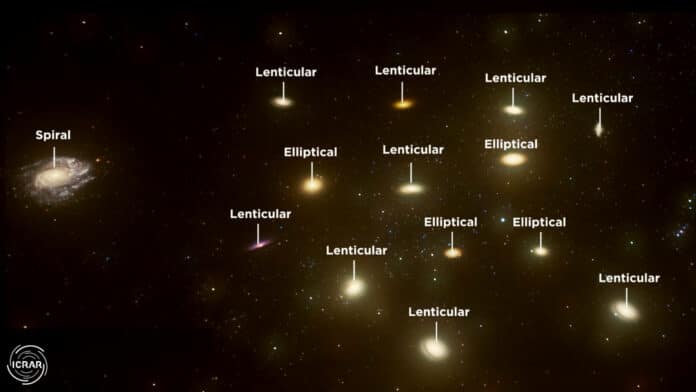The optical morphology of galaxies is strongly related to the galactic environment, with the fraction of early-type galaxies increasing with local galaxy density. A new study led by astronomers at the International Centre for Radio Astronomy Research (ICRAR) presented the first analysis of galaxy morphology. Scientists have uncovered the reason behind differences in the shape of the galaxy.
Lead author Dr. Joel Pfeffer from The University of Western Australia node of ICRAR said the research explains the ‘morphology-density relation’ – where clustered galaxies appear smoother and more featureless than their solo counterparts.
“We’ve discovered a few different things going on when we get lots of galaxies packed together,” Dr. Pfeffer said.
“The spiral arms on galaxies are so fragile, and as you go to higher densities in the galaxy clusters, spiral galaxies start to lose their gas.
“This loss of gas causes them to ‘drop’ their spiral arms, transforming into a lenticular shape.”
“Another cause is galaxy mergers, which can see two or more spiral galaxies crashing together to form one large elliptical galaxy in the aftermath.”
For the study, scientists used the powerful EAGLE simulations to analyze a group of galaxies in detail. They used an AI to classify galaxies by their shape.
Scientists may confidently use the simulation results to understand observations of galaxy clusters since the simulations closely mimic what has been observed in the Universe.
In addition, the study discovered several lenticular galaxies outside of the high-density regions where they are often found, and the modeling indicates that these galaxies were formed by the merger of two other galaxies.
Dr. Pfeffer said the work brings together various pieces of research in the galactic evolution to understand the morphology-density relation for the first time.
“There’s been lots of suggestions over time. But this is the first work to put all of the pieces of the puzzle together.”
Journal Reference:
- Joel Pfeffer et al. The galaxy morphology–density relation in the EAGLE simulation. Monthly Notices of the Royal Astronomical Society. DOI: 10.1093/mnras/stac3466
